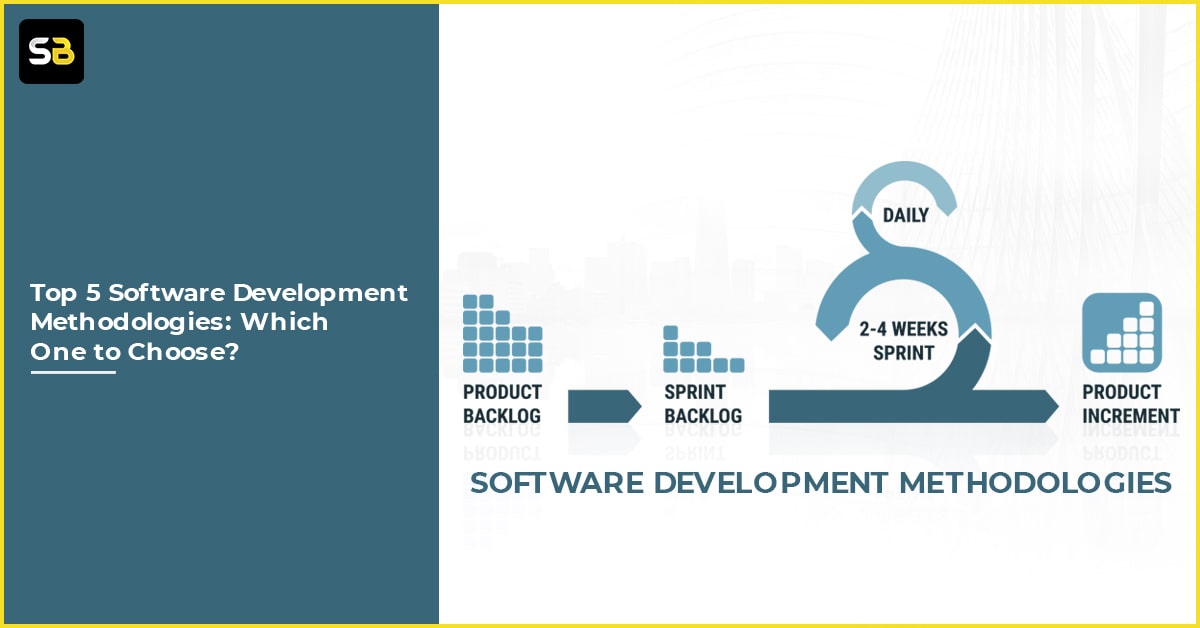
- Aug 18, 2022
Top 5 Software Development Methodologies: Which One to Choose?
Today's technology is developing quickly, forcing software development companies to compete and work in situations with intense competition. The processes or series of processes used in software development are called methodologies. The software development industry depends heavily on development methodologies. To create different kinds of applications, there are numerous software development methodologies available. Making the appropriate choice is essential to finishing the project on schedule and with the greatest results. Understanding the various development methodologies and their advantages and disadvantages is crucial before embarking on a software development journey. The best software development methodologies will be discussed in this post in order to determine which one best suits your functional and business needs.
Kinds of Software Development Methodologies:
The development team or project managers must select the optimal development technique in order to manage and complete the project successfully. Each project management technique has advantages and disadvantages. Let's examine the best methods in greater detail for your project.1. Agile Development Methodology
 Adaptive planning, evolutionary development, and continuous improvement through adaptability to change are the main focuses of the more well-known agile software methodology. The primary objective of this process is to deliver early software releases with a lower likelihood of defects or errors.
Agile encourages testing and development iterations that continue throughout the whole development cycle. Testing and development happen simultaneously under the agile methodology. This methodology reduces the risks associated with integrating new features or functionality into the program, such as errors, costs, and more. Numerous agile development techniques exist, including feature-driven development, crystal, scrum, and extreme programming (XP) (FDD). Scrum and Kanban are the two agile methodologies that are most frequently employed.
Today, the Agile methodology is quickly gaining traction in businesses of all sizes. 80% of significant IT Companies' projects are currently employing "Agile" or "iterative," according to a Deloitte assessment. The programmer may create the product more quickly and effectively using this method. Agile is a development methodology that is team-based and more adaptable.
In this method, the development effort is divided into sprints, which are discrete phases. The members of the project development team will adhere to a list of deliverables for each sprint, which will last for a few weeks. The Scrum master, the team members, and themselves review the work at the end of the sprint.
Agile Development Advantages
Adaptive planning, evolutionary development, and continuous improvement through adaptability to change are the main focuses of the more well-known agile software methodology. The primary objective of this process is to deliver early software releases with a lower likelihood of defects or errors.
Agile encourages testing and development iterations that continue throughout the whole development cycle. Testing and development happen simultaneously under the agile methodology. This methodology reduces the risks associated with integrating new features or functionality into the program, such as errors, costs, and more. Numerous agile development techniques exist, including feature-driven development, crystal, scrum, and extreme programming (XP) (FDD). Scrum and Kanban are the two agile methodologies that are most frequently employed.
Today, the Agile methodology is quickly gaining traction in businesses of all sizes. 80% of significant IT Companies' projects are currently employing "Agile" or "iterative," according to a Deloitte assessment. The programmer may create the product more quickly and effectively using this method. Agile is a development methodology that is team-based and more adaptable.
In this method, the development effort is divided into sprints, which are discrete phases. The members of the project development team will adhere to a list of deliverables for each sprint, which will last for a few weeks. The Scrum master, the team members, and themselves review the work at the end of the sprint.
Agile Development Advantages
- Increases the effectiveness of finding and repairing issues
- Accelerate product delivery while improving product quality
- Aids in preserving transparency during development
- The large team's ability to cooperate and develop applications is simple.
- It decreases important and vital errors and helps deliver the finished product on schedule. (Development doesn't take any more extended time)
- Complex applications can be created by programmers with a lesser probability of errors.
- The achievement of a ready-for-release state requires ongoing testing and feedback.
- Programmers profit from discovering more effective methods for solving problems.
- This approach is not suitable for beginners (Inexperience developers).
- Your team should be made up of professional and experienced developers.
- To complete the project, the team members need considerable training in order to comprehend the model.
- The other team members, including the testers, developers, and consumers, should be in continual touch with one another. As a result, this may be tedious and overwhelming.
- Development methodologies rely on real-time communication, and if you have a new team member, a lack of documentation during the development process will cause problems and misunderstandings.
2. Waterfall Development Methodology
 The oldest and most popular development methodology is the waterfall model. Winston W. Royce first introduced the waterfall model in 1970. It follows a traditional cycle for developing applications, and the Waterfall technique is a sequential model that splits development into a number of predetermined phases. There cannot be any overlap between the phases; one must be finished before the next may start. This method of development prevents us from going back and making modifications to earlier stages.
The Phases of the Waterfall Model
The development cycle for the waterfall approach involves five to seven stages. The preceding phase must be finished before the developer can start the subsequent one.
The oldest and most popular development methodology is the waterfall model. Winston W. Royce first introduced the waterfall model in 1970. It follows a traditional cycle for developing applications, and the Waterfall technique is a sequential model that splits development into a number of predetermined phases. There cannot be any overlap between the phases; one must be finished before the next may start. This method of development prevents us from going back and making modifications to earlier stages.
The Phases of the Waterfall Model
The development cycle for the waterfall approach involves five to seven stages. The preceding phase must be finished before the developer can start the subsequent one.
- Gathering customer requirements
- Designing
- Implementation
- Verification (Customer review and make sure the product satisfies the criteria)
- Maintenance (The production team focuses on feature requirements and will find and repair bugs)
- This methodology is straightforward and user-friendly.
- There are specific deliverables for each stage as well as unique survey metrics.
- For inexperienced developers, the waterfall model is advantageous.
- For smaller projects when demands are clearly defined, this development strategy is more productive.
- Simple testing procedure
- When it is possible to reach the exact straight front, this way can be used.
- For products that require maintenance, this model is inappropriate.
- Up until the application completes the SDLC, it is not possible for it to be usable.
- It is not feasible to update or add new features once the application has entered the testing phase.
- There is no choice to realize the task's final result.
- Not recommended for long-term or continuous projects.
3. DevOps Deployment Methodology
 The phrases "development" and "IT operations" are combined to form the term "DevOps." Agile is not replaced by DevOps, which is a more recent methodology that comes after agile. The goal of this software development methodology is to successfully integrate information technology and software development teams. Instead of partitioning the roles and duties, it places an emphasis on continuing cooperation across all development stages. It eliminates the obstacles that existed between the IT operation team and the development team. Cross-functional teams are brought together using DevOps methods to make project development more efficient, streamlined, and bug-free. The DevOps methodology fosters team collaboration.
The seven phases of the DevOps lifecycle are listed below:
The phrases "development" and "IT operations" are combined to form the term "DevOps." Agile is not replaced by DevOps, which is a more recent methodology that comes after agile. The goal of this software development methodology is to successfully integrate information technology and software development teams. Instead of partitioning the roles and duties, it places an emphasis on continuing cooperation across all development stages. It eliminates the obstacles that existed between the IT operation team and the development team. Cross-functional teams are brought together using DevOps methods to make project development more efficient, streamlined, and bug-free. The DevOps methodology fosters team collaboration.
The seven phases of the DevOps lifecycle are listed below:
- Continuous Development
- Integration
- Continuous Testing
- Monitoring
- Continuous Feedback
- Deployment and
- Operations
- Adopting the DevOps framework has considerable advantages for the business in terms of boosting high-quality goods, decreasing disruption, accelerating time to market, and enhancing team productivity and effectiveness.
- Reduce the intervals between error repairs.
- With DevOps, the project development team may provide a product or service with Zero Defects.
- Lower the new release failure rate
- Fast sprint cycles
- Using the appropriate technique accelerates the delivery of products in a more precise and beneficial manner.
- Automating processes to increase profits
- By utilizing DevOps, even huge enterprises may create scalable businesses and maximize results.
- Few clients don't require ongoing framework changes.
- Upon completion of the development and testing phases, some businesses will move to the operational phase.
4. Rapid Application Development
 The rapid application development model uses prototyping rather than in-depth planning to create the application. RAD is an effective methodology that produces outcomes more quickly and of higher quality than other methods for software development. The development work receives higher priority under the RAD model, whereas planning is given less attention. With the help of this technique, software can be developed more quickly throughout the full development cycle. Goals are rapidly created when users actively participate in the development process.
The RAD involves the following 4 phases:
The rapid application development model uses prototyping rather than in-depth planning to create the application. RAD is an effective methodology that produces outcomes more quickly and of higher quality than other methods for software development. The development work receives higher priority under the RAD model, whereas planning is given less attention. With the help of this technique, software can be developed more quickly throughout the full development cycle. Goals are rapidly created when users actively participate in the development process.
The RAD involves the following 4 phases:
- Requirements planning
- User design / Prototype Cycle
- Rapid construction
- Testing and Cutover
- The product engineer faces fewer risks and work requirements thanks to the RAD model.
- The clients can quickly audit the application thanks to it.
- Customer feedback, which continually provides the possibility for improvement on any project development, is supported by this RAD methodology.
- This RAD model depends on the solid individual and team performance.
- It demands a highly talented programmer and designer; not all firms can afford to have more skilled team members.
- For projects with a minimal budget, this strategy is not appropriate. Modeling and code automation are extremely costly.
5. Prototype Methodology
 The software development process known as the Prototype Methodology allows developers to merely produce a prototype of the solution to show clients how it works. Utilizing this process, make any necessary adjustments before creating the actual application. The fact that this software development methodology addresses a wide range of problems that frequently arise in a conventional waterfall model is by far its best feature.
Prototype Methodology Advantages
The software development process known as the Prototype Methodology allows developers to merely produce a prototype of the solution to show clients how it works. Utilizing this process, make any necessary adjustments before creating the actual application. The fact that this software development methodology addresses a wide range of problems that frequently arise in a conventional waterfall model is by far its best feature.
Prototype Methodology Advantages
- To ensure that the client has a thorough grasp and "feel" for the functionality created in the software, show them the prototype. It guarantees higher levels of comfort and client satisfaction.
- By employing this method, the chance of failure can be significantly decreased. Potential hazards can then be immediately identified and mitigated.
- Determine the refinement's scope and adjust the requirements to take into account the new modifications.
- A very positive and conducive environment is created by the communication between the client and the software development team during a project.
- When necessary documents are absent, it aids in requirement analysis and gathering.
- Since prototyping is typically done at the expense of the developer, it should be done with the fewest resources possible to avoid greatly increasing the organization's development costs.
- Too many clients are involved, which isn't necessarily in the software developer's best interest.
- Sometimes after seeing an early prototype, customers demand delivery of the finished product.
- Too many changes to the project are not welcomed because they can easily disrupt the current workflow of the entire software development process.
- After seeing the initial prototype, customers might not be happy or interested in the concept.
Conclusion
Any application development would benefit from using the software development methodology. You can better understand development methods and choose the one that best fits your development process with the aid of the aforementioned overview and the advantages and disadvantages of each method. The right development approach must be first chosen in order to get the intended outcome. Spend the time on goal-oriented planning, the budget, resource planning, product development, timeline, etc. You can determine which procedure will best suit you to complete the project by using software development methodology.Our Office

USA
Florida
S Beach St #100 Daytona Beach, FL 32114
United States Of America
+1-4073-743-746

Australia
Sydney
Rubix Alliance Pty Ltd Suite 305/30 Kingsway, Cronulla NSW 2230
+61-1800-682-147

India
Kolkata
Adventz Infinity, Office No - 1509 BN - 5, Street Number -18 Bidhannagar, Kolkata - 700091 West Bengal
+91-8335-038-522
India
Bengaluru
KEONICS, #29/A (E), 27th Main, 7th Cross Rd, 1st Sector, HSR Layout, Bengaluru, Karnataka 560102
+91-9163-413-459








